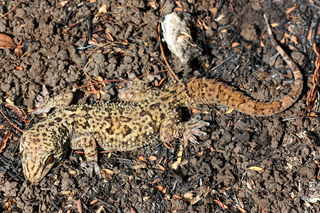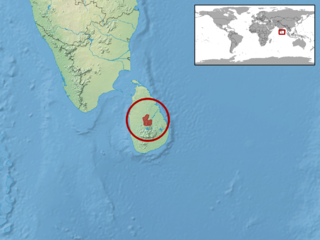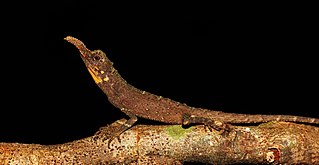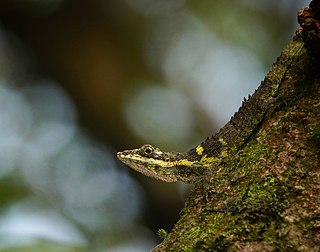
Lyriocephalus is a genus of lizard within the agamid family, with the sole species Lyriocephalus scutatus. It is the largest agamid endemic to Sri Lanka and lives in dense wet zone forests. It is also called the hump-nosed lizard, hump snout lizard or the lyreshead lizard. In Sinhalese language, it is known as "Kandukara Bodilima – කදුකර බෝදිලිමා."

The Bengal monitor, also called the common Indian monitor, is a monitor lizard distributed widely in the Indian Subcontinent, as well as parts of Southeast Asia and West Asia. This large lizard is mainly a terrestrial animal, and its length ranges from about 61 to 175 cm from the tip of the snout to the end of the tail. Young monitors may be more arboreal, but adults mainly hunt on the ground, preying mainly on arthropods, but also taking small terrestrial vertebrates, ground birds, eggs and fish. Although large Bengal monitors have few predators apart from humans who hunt them for meat, younger individuals are hunted by many predators.

Calotes calotes, the common green forest lizard, is an agamid lizard found in the forests of the Western Ghats and the Shevaroy Hills in India, and Sri Lanka.

The Indian chameleon is a species of chameleon found in Sri Lanka, India, and other parts of South Asia. Like other chameleons, this species has a long tongue, feet that are shaped into bifid claspers, a prehensile tail, independent eye movement, and the ability to change skin colour. They move slowly with a bobbing or swaying movement and are usually arboreal. Strangely, they do not choose the background colour and may not even be able to perceive colour differences. They are usually in shades of green or brown or with bands. They can change colour rapidly and the primary purpose of colour change is for communication with other chameleons and for controlling body temperature by changing to dark colours to absorb heat.

Hemidactylus maculatus, also known as the spotted leaf-toed gecko or giant spotted gecko, is a species of large gecko found in the Western Ghats of India and in parts of Sri Lanka.

The Kandyan day gecko or Kandyan rock gecko is a species of diurnal gecko found in Sri Lanka.
Uropeltis ceylanica is a species of nonvenomous shieldtail snake in the family Uropeltidae. The species is endemic to the Western Ghats of South India. No subspecies are currently recognized as being valid, but the presence of several synonyms, many recently resurrected, calls for further taxonomic studies of this species complex. It is a burrowing snake with a pointy head equipped to penetrate the soil. It has a thick tail which looks as if it has been cut at an angle. In Kerala it's called iru thala moori, which means two headed organism, as the tail end looks like another head. It primarily eats earth worms.
Uropeltis melanogaster, or Gray's earth snake, is a species of small snake in the family Uropeltidae, endemic to Sri Lanka.

Pareronia ceylanica, the dark wanderer, is a medium-sized butterfly of the family Pieridae, that is, the yellows and whites. It is found in Sri Lanka and India.

The rough-nosed horned lizard or Sri Lanka horned agama is an Agamid lizard from Sri Lanka in lowland dipterocarp forests and secondary forests in the wet zone. It is distinguished from all the other Ceratophora species by the presence of a complex rostral appendage, comprising more scales than rostral scale alone. The lateral body scales are small and more or less regular shape.
Aspidura copei, commonly known as Cope's rough-sided snake or කලු මැඩිල්ලා in Sinhalese, is a species of snake in the family Colubridae. The species is endemic to Sri Lanka.
Aspidura drummondhayi, commonly known as Drummond-Hay's rough-sided snake or කෙටිවල් මැඩිල්ලා in Sinhala, is a species of snake in the family Colubridae. The species is endemic to Sri Lanka.

The whistling lizard or Sri Lanka agama is a species of lizard in the family Agamidae. It is one of four Calotes species endemic to Sri Lanka.

Cophotis dumbara, the Dumbara agama, is an agamid species endemic to Sri Lanka. Known only from Knuckles Mountain Range. It is classified as a critically endangered species due to habitat loss and logging.
Cyrtodactylus soba, also known as the Dumbara bent-toed gecko or Knuckles bent-toed gecko, is a species of gecko endemic to island of Sri Lanka.
Lankascincus taylori, commonly known as Taylor's tree skink, is a species of lizard in the family Scincidae. The species is endemic to the island of Sri Lanka.
Smith's snake skink, also known as the two-legged nessia, is a species of skink endemic to island of Sri Lanka.
Dendrelaphis oliveri, commonly known as Oliver's bronzeback, is a species of nonvenomous arboreal snake in the family Colubridae. The species is endemic to Sri Lanka. It is considered to be the rarest of the Sri Lankan Dendrelaphis species on account of there being only a single recorded specimen.
Cnemaspis kotagamai, or Kotagama's day gecko, is a species of diurnal gecko endemic to island of Sri Lanka, described in 2019 from Ratnapura.
Cnemaspis dissanayakai, or Dissanayaka's day gecko, is a species of diurnal gecko endemic to island of Sri Lanka, described in 2019 from Polonnaruwa.










